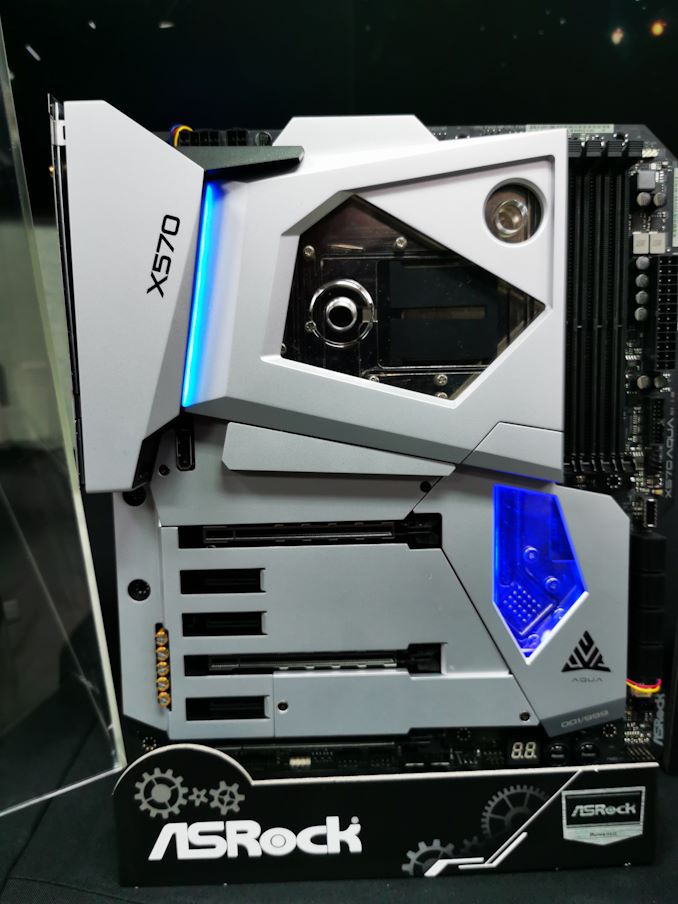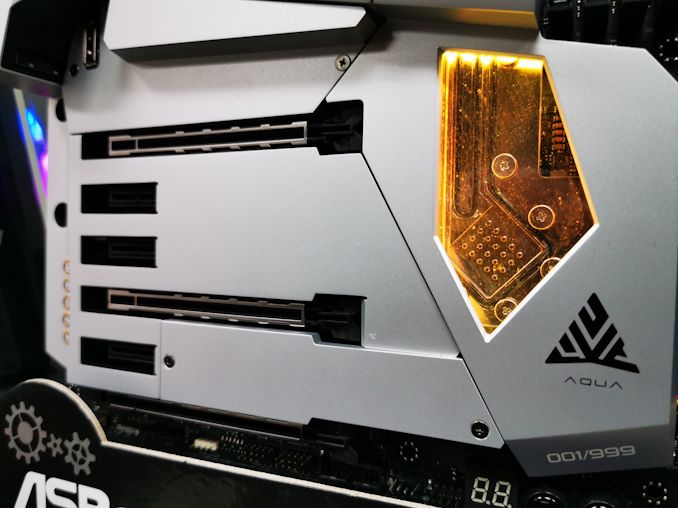The AMD X570 Motherboard Overview: Over 35+ Motherboards Analyzed
by Gavin Bonshor on July 9, 2019 8:00 AM ESTASRock X570 Aqua
Starting off alphabetically with ASRock, we open our X570 chipset overview with one of the most impressive and talked about models displayed at Computex, the ASRock X570 Aqua. ASRock's product stack is well varied with models focused on gaming, content creators, professional, and enthusiasts, the X570 Aqua certainly positions itself as high-end with a solid feature set, an elegant aesthetic which resembles that of Robocop's armor, and offers users an element of exclusivity due to that fact ASRock will only make 999 pieces of the X570 Aqua available to consumers.
The first thing that stands out about the ASRock X570 Aqua is the full-cover PCB armor covering the vast majority of the PCB and the large CPU water block. The ASRock X570 Aqua is an E-ATX board which has a large water block which is designed to keep the CPU cooled, and also extends to cool the X570 chipset. The armor, and the backplate on the rear makes the board much heavier than other premium models we've come to see in recent times.
The feature set underneath the aesthetics is equally premium with an Aquantia AQC107 10 G LAN port, with an additional Intel Gigabit port included. Its Wi-Fi 6 capabilities come due to a Killer AX1650 802.11ax interface which also adds support for BT 5. A Realtek ALC1220 HD audio codec provides the onboard audio, while the rear panel also uses two Thunderbolt 3 Type-C ports. This limits the boards other USB 3.1 G2 capabilities and as a result, the X570 Aqua has six rear-panel USB 3.1 G1 type-A ports, but users can add an additional four with two USB 3.1 G1 headers, and four USB 2.0 ports with a pairing of USB 2.0 headers.
One of the main features of X570 is PCIe 4.0, and the ASRock X570 Aqua makes use of three full-length PCIe 4.0 slots which run at x16 x8/x8 and x8/x8/x4; also present is three PCIe 4.0 x1 slots. Storage includes two PCIe 4.0 M.2 slots and a total of eight SATA ports. ASRock gives the X570 Aqua some impeccable memory support which is listed as DDR4-4666.
The ASRock X570 Aqua is currently ASRock's flagship X570 motherboard in terms of features, and aesthetics. We know that the ASRock X570 Aqua will be limited to just 999 pieces worldwide, making its exclusivity one of its attracting features. The Aqua moniker signifies the targeted consumer of this board, in that only users looking to run a custom water cooled system with high-end components, will likely consider this model. This is likely to be a favorable model for case modders, or perhaps users looking to create an elegant water-cooled system with a form of exclusivity and individuality.
With an element of exclusivity, the ASRock X570 Aqua has an MSRP of $1000. This makes it the most expensive X570 model at launch, but this is expected due to the limited nature as it is limited to just 999 pieces worldwide. A heavy-set construction, the PCB covering armor and coupled with a top quality feature set make this a top option for modders, and water cooling enthusiasts.












225 Comments
View All Comments
abufrejoval - Tuesday, July 9, 2019 - link
It's amazing how quickly you run out of PCIe lanes, when you don't have switches to multiplex and translate between PCIe revisions and lanes (e.g. PCIe v4 x2 <-> PCIe v2 x8).I find myself using USB 3.x NBase-T NICs and NVMe adapters, simply because they *do* switch.
Bensam123 - Tuesday, July 9, 2019 - link
Maybe a bit more depth on the power delivery page. I have absolutely no idea how to go about parsing what's there. More chokes is better? What denotes a power phase?A5 - Tuesday, July 9, 2019 - link
+1. Some analysis of that information would be helpful.MrSpadge - Tuesday, July 9, 2019 - link
+1bunkle - Wednesday, July 10, 2019 - link
The controller column includes the total number of phases supported split between CPU cores and SoC e.g. (6+1) = 6 CPU phase and 1 SoC phase. More is *usually* better but has diminishing returns regarding tighter and tighter voltage regulation. Some controllers are better than others (can operate at high frequency e.g. 500KHz v 1000KHz, include other features to improve performance) mitigating the need for more phases.Each phase is a buck converter comprised of a low/high side MOSFET (can be integrated in a single package) and choke. Some controllers can support doubling up the PWM signal to driver more MOSFETs. Doublers can also be added as discrete components if not built into the controller.
Current rating of the MOSFET (e.g. Sic639=40A IR3555=60A) indicates the total power deliverable. MOSFETs are not 100% efficient and vary in efficiency. The more current they provide the hotter they get and the less efficient they become, with better MOSFETs producing less heat for a given current. Thus using doubles can improve temperatures and efficiency without the benefits of the tighter voltage tolerance that *real* phases provide.
Hope that’s helpful!
bunkle - Wednesday, July 10, 2019 - link
A lot more detailed explanation: https://en.wikichip.org/wiki/voltage_regulator_mod...bug77 - Tuesday, July 9, 2019 - link
The description for AsRock X570(M) Pro4 says "5 jack + 1 SPDIF". Unfortunately, those boards lack SPDIF and only come with 3 jacks ;)Smell This - Tuesday, July 9, 2019 - link
I'm thinking the *ASRock Thunderbolt AIC* ...https://thunderbolttechnology.net/product/asrock-t...
would cover all your TBT peripheral needs, including optical.
DanNeely - Tuesday, July 9, 2019 - link
Do X570 boards still need an extra chip per USB port to support USB-C reversibility?The additional expense and needed PCB space were cited as among the reasons why earlier generation boards (IIRC both Intel and AMD) almost never had more than 1 C port; but it was never clear to me if that was an inherent implementation penalty for the C port or an artifact of Intel's tech stack being stalled out and AMD outsourcing to ASMedia which built the chipsets on an ancient (55nm) platform.
DigitalFreak - Tuesday, July 9, 2019 - link
Gavin - X370 and X470 only supported PCIe 2.0. The connection between the CPU and chipset was 3.0, but all the ports on the chipset were 2.0.